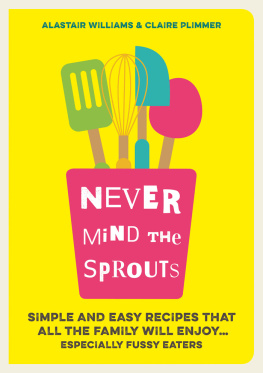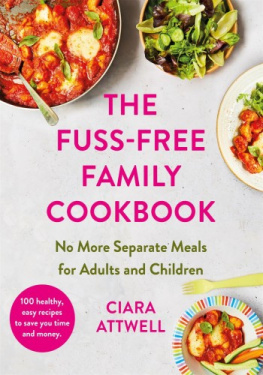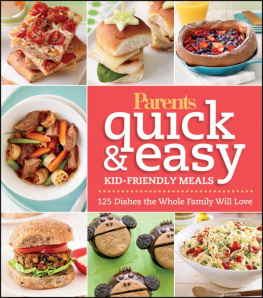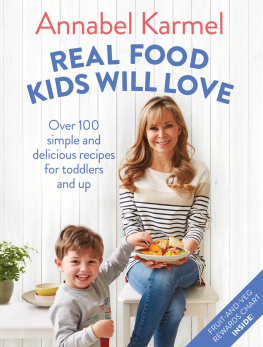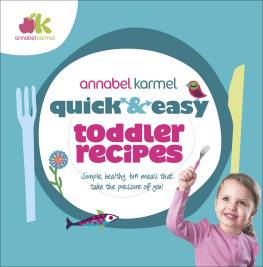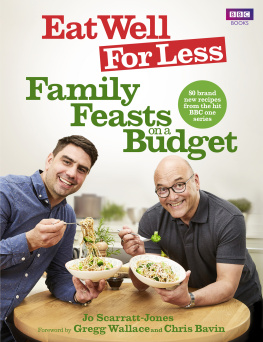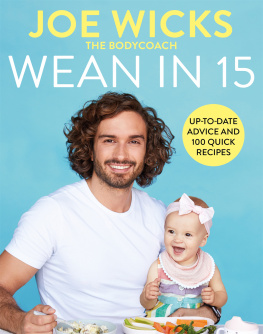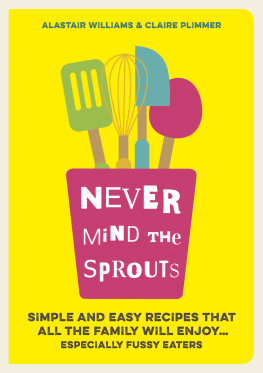NEVER MIND THE SPROUTS
Copyright Alastair Williams and Claire Plimmer, 2015
All rights reserved.
No part of this book may be reproduced by any means, nor transmitted, nor translated into a machine language, without the written permission of the publishers.
Alastair Williams and Claire Plimmer have asserted their right to be identified as the authors of this work in accordance with sections 77 and 78 of the Copyright, Designs and Patents Act 1988.
Condition of Sale
This book is sold subject to the condition that it shall not, by way of trade or otherwise, be lent, re-sold, hired out or otherwise circulated in any form of binding or cover other than that in which it is published and without a similar condition including this condition being imposed on the subsequent purchaser.
Vie Books is an imprint of Summersdale Publishers Ltd
Summersdale Publishers Ltd
46 West Street
Chichester
West Sussex
PO19 1RP
UK
www.summersdale.com
Printed and bound in the Czech Republic
eISBN: 978-1-78372-574-8
Substantial discounts on bulk quantities of Summersdale books are available to corporations, professional associations and other organisations. For details contact Nicky Douglas by telephone: +44 (0) 1243 756902, fax: +44 (0) 1243 786300 or email: .
This book is dedicated to
Kitty, Freddie, Elizabeth and Piers,
with all our love
CONTENTS
INTRODUCTION
You may have picked up this book because you would love your child to be a good eater not a fussy eater a child whos consuming a nutritious and balanced diet. Its only natural.
From the moment we become parents, it seems that we are programmed to worry and one of our key concerns is to make sure our child eats well so that he or she grows and develops healthily. The worry that your child has not put on those requisite ounces during their formative weeks is the start point of a concern that can gather momentum as milk feeds switch to the weaning process and beyond.
There is so much advice available to parents with regard to how best to nourish a child, and whole industries have been established around this topic. You may still be haunted by the guilt that during the weaning process you didnt have the time (or maybe the inclination) to steam, pure and pack ice cube trays full of organic vegetables in order to prepare baby-sized chunks of frozen goodness. And even if you did go through the trials of such preparation, all of your hard work and effort may have been thwarted when your child took one baby spoonful of the warmed-up goo only to projectile spit it out at you. Maybe things didnt get any better for you as they moved on to finger food, preferring a strict diet of breadsticks against any sniff of a carrot baton.
It could be that the transition to full meals saw no further joy. At a time when we know its crucial for our childs health that they eat the correct amount of vitamins, minerals, proteins and starches, your child wont touch anything green and turns their nose up at any kind of protein. Your friends children appear to be eating really well, yet all your child wants to munch on is jam sandwiches.
If this sounds all too familiar fear not; you are not alone. Many parents encounter these kinds of scenarios and, try as you might to create a model eater, mealtime battles are experienced by what seems to be the vast majority of us. If you have a child who does not clap their hands in delight when you serve up a good for you dish, dont beat yourself up, there will usually be a way to find something nourishing that theyll like, and that something could be a simple dish of homemade fish fingers and peas. We wont guarantee that your child will suddenly eat everything but, with a little help from this book, there can be light at the end of the tunnel.
There are usually ways to get through eating barriers and one of the best places to start is for you to stop being stressed about it. Tastes can be developed and a more varied diet is achievable.
As authors, we are not parenting or nutritional experts; we are parents with experience of dealing with difficult eaters. This book is designed to give some pointers on ways you can try to change poor eating habits or break down the barriers that may have been formed against eating, such as decisions not to eat certain foods that have been made based on a bad eating experience. It also provides you with a one-stop shop of ideas and recipes for simple meals and snacks, all delivered with straight-forward preparation instructions.
Some of the recipes within this book are very basic and not always true to some of the original recipes that you might know and trust they simply offer a start point that can be embellished as your childs tastes develop.
That said, each recipe in this book is based on simple yet nutritious ingredients that are easy to prepare for busy parents. Alongside some recipes to cook, weve included some no-cook ideas raw food can have greater health benefits than cooked.
Youll soon discover that not only can food become a great adventure that children will want to join you on, but you could save money by preparing things from scratch.
As part of the research for this book we questioned close to 200 parents and their children to find out what their best and worst foods are, why they like or hate things and what made them change their minds about certain foods. We asked parents what issues they faced with fussy eaters and garnered their opinions about what worked or didnt work for them in their attempts to persuade children to eat. From the evidence collected, one key conclusion can be drawn: tastes do develop and change as children grow older, so its worth persevering with your child in your quest to change their eating habits. The results of the questionnaire are documented within the book, and useful comments made by parents are sprinkled throughout. Thank you to all of you who helped us with this survey.
We hope that youll find some quick-win suggestions here, as well as some recipes that will turn into family favourites.
THE BASICS
Common sense
The recipes in this book are designed with simplicity in mind, both in terms of equipment and cooking skills required. Before you try any recipe, read it through first to make sure you have all the ingredients and equipment as well as the time to prepare it. One handy piece of kit to have in the kitchen if you have a fussy eater is a blender (either the handheld variety or the stand alone) as many of the recipes have the option of blitzing ingredients to make them more palatable for your child.
Conversion chart
The recipes in this book are given in metric measurements, but many small amounts are measured in terms of spoons.
The following abbreviations are used:
tbsp = tablespoon
tsp = teaspoon
1 tbsp = 25 g of syrup, jam, honey, etc.
2 tbsp = 25 g of butter, sugar
3 tbsp = 25 g of cornflour, cocoa, custard powder, flour
4 tbsp = 25 g of grated cheese, porridge oats
All spoon measures refer to level spoons, not heaped.
In all recipes the oven should be heated to the temperature stated prior to cooking to allow it to warm up. Ovens may vary but as a rule of thumb, Celsius is roughly half the Fahrenheit temperature.
Set fan-assisted ovens 25 degrees Celsius (approximately 50 degrees Fahrenheit) lower than others or reduce the cooking time by 10 minutes for every hour of cooking time.
Advice on freezing

